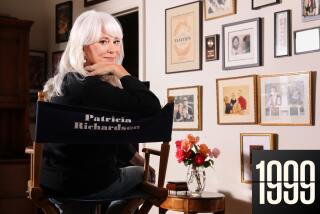Ronald K. Brown’s Evidence dance company proves the power of faith
At a time when atrocities in the name of religion dominate world news, choreographer Ronald K. Brown reminds audiences how faith can unite us, heal us and help us get through the worst that life and human nature can inflict. For more than 30 years his New York-based Evidence company has used a sophisticated amalgam of Afrocentric movement and modern dance to make spirituality not merely a passive state but something vibrant and transformative.
In a mostly familiar three-part program at the Broad Stage on Friday (the first of two performances), Evidence continually showed dancers on the sidelines watching their colleagues -- their rapt attention drawing us deeper into the works on view. Although “Grace” (1999 and 2004) developed into a powerful ensemble showpiece, it began and ended with a fervent danced prayer and found the supremely elegant Clarice Young functioning as teacher and inspiration to the others, most notably the rebellious Taylor Jones.
Music by Duke Ellington, Roy Davis Jr. and Fela Anikulapo Kuti frequently generated unison ensembles aimed straight at the audience, but almost as often Brown depicted personal feelings and relationships. Flamboyant turning-jumps and passionate embraces -- the bold contrasts in “Grace” illuminated an inclusive view of creative expression.
This playoff between choreographic patterning and individual emotion dominated “Come Ye” (2002) to music by Kuti and the great Nina Simone. Indeed, the two elements were often layered, as when men danced rhythmically at the back of the stage while women in front shared their grief and pain through intimate gestural detail. The end of the piece added yet another layer: Robert Penn’s documentary video, projected behind the dancing, which intercut clips of protests and arrests with glimpses of culture-heroes including Gandhi and Martin Luther King Jr.
Apart from the video and the lyrics of Simone’s songs, Brown used images of the fallen, the Black Power clenched fist held high and a sense of the dancers as witnesses to history to enhance the work’s political implications, anticipating “Black Lives Matter” as a statement about resistance to racist violence.
With a title that made reference to Allah, “The Subtle One” (2014) featured hectic jazz eruptions by Jason Moran and the Bandwagon and a dance style of focused purity, especially in a sharp-edged solo by Annique Roberts. Periodically the dancers came forward, arms outstretched -- not in supplication but as if making an offering -- only to draw back in fear. In other motifs, clenched hands opened out in a release of tension and a slow backbend became a meditative act of submission. And, as always with Brown, small peripheral actions took you by surprise: Jones and Keon Thoulouis leaving the stage hand in hand, for example.
“The Subtle One” may have been almost totally abstract but never coldly formal, never an attempt to nullify dancer individuality. And the loose, flowing costumes by Keiko Voltaire created a cross-cultural ambiance, something fusing many influences -- like the masterful movement itself.
The dancers in Evidence also included Brittany Ballentine, Shayla Alayre Caldwell, Arcell Cabuag and Brown.
Follow The Times’ arts team @culturemonster.
More to Read
The biggest entertainment stories
Get our big stories about Hollywood, film, television, music, arts, culture and more right in your inbox as soon as they publish.
You may occasionally receive promotional content from the Los Angeles Times.










